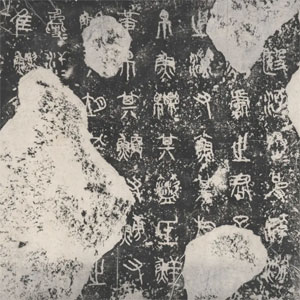11.8.24 — Which Came First?
The oldest work in a show of “Chinese Painting and Calligraphy” is neither painting nor calligraphy. You might not know that, though, which only adds to its fascination at The Met.
It sure looks like calligraphy, but the characters have turned a ghostly white. Nor do they appear alongside a landscape as in so much Chinese art, although they seem to inhabit one—blending into a rocky, watery, or forested expanse.  It takes on the texture of landscape as well, with eerie white slabs against a grainy black. As long ago as the fifth century B.C.E., an unknown artisan carved the cryptic characters into stone before rubbing them with ink and transferring them onto paper. Long before photography, it is the ultimate paper negative. It should have you wondering at the relationship between painting and calligraphy in the centuries of art to come, through January 5.
It takes on the texture of landscape as well, with eerie white slabs against a grainy black. As long ago as the fifth century B.C.E., an unknown artisan carved the cryptic characters into stone before rubbing them with ink and transferring them onto paper. Long before photography, it is the ultimate paper negative. It should have you wondering at the relationship between painting and calligraphy in the centuries of art to come, through January 5.
Chinese painting and calligraphy—it must sound like the entirety of Chinese art. And the Met often rehangs its Asian wing to showcase its collection, most recently in its space for Korean art. Sometimes the rooms for China convey a theme, like “Companions in Solitude,” whereas this time they approach a comprehensive history. Far be it from me to try for one myself. Consider then an amateur’s chance impressions and a single question: what are painting and calligraphy doing together in the first place?
You may take for granted that Chinese poetry and landscape were conceived together, in contemplating art and nature. That early work, though, has no true landscape at all, and each stage in its creation ruled out the fluency and precision of a fine brush in the artist’s hand. Other works have at most a token inscription, in descending letters. The Met throws in other media as well, with enamelware, porcelain, and silver for what the painted images represent. The installation ends with three scrolls of portrait busts from the 1700s. The interplay between Asia and the West has begun in earnest, and the fluidity of ink has given way to hard outlines and firm color.
Those portraits may compile a family history or a procession of scholars, but then most Chinese art looks to its ancestors. Could a backward glance be the secret of pairing art and text as well? The show opens with exactly what you might expect—sheets of painting and calligraphy mounted together. They stake out a point of origin, a millennium ago or more, only they date from up to three hundred years apart, and dates for either one are hard to pin down. The Met calls its hanging “roughly” chronological, and you can see why. It can still display a coherent history.
Is it about shared visions or influences, and can one even tell the two apart? Often the text, clear and dark, vies with the subtlety and lightness of painting, but which came first? Calligraphy here may be a colophon (which, I fear, the Met does not trouble to translate)—not the date and place of publication as in printing practices today, but a kind of commentary, in poetry and prose. By the 1600s, though, poetry comes can take priority as well. Does that make the whole an illustrated book? If so, calligraphy is itself an art, both text and illustration.
Remember an old truth in Western literature—that the greatest of all must die, but trees live on as a glimpse of eternity? Shitao, a poet, knows that “no old tree can gain its youth again” either, and it makes him wonder why he writes. Poignant as it is, it returns to the theme of authority and ancestry. They are explicit when armies gather and palaces hold sway. They are clearer still in the 1300s, with drawings of women at court. They have hair like helmets, in parallel stokes that a greater freedom has yet to disturb.
Power may yet require accommodations (and the Met never once mentions religion). The women look after their children or stake a claim for themselves—at least one dressed as a man. Nestled trees with a crown in their branches may stand for Mongol rule or a peace surpassing it. In the fifteenth century, with Fang Congyi and others, authority must take a back seat to a softer handling, a mistier landscape, and a “beneficent rain.” A scroll’s long format from Zhang Yucai makes that rain all the more encompassing. Ancestry is everything, but there is no looking back.
Calligraphy, too, takes on a life of its own—bold to the point of ink blots, although never again the spatters of that ancient rubbing on stone drums. You can almost imagine a history akin to that of European art, from the certainties of the Middle Ages to the artistic personalities of the Renaissance. The Baroque, in this history, would take one last step, at risk of losing art’s hand-won playfulness and atmosphere. Simplistic? Sure, and I cannot claim the expertise to say more. Still, it undermines the settled truths of a single, shared role and loving collaboration for calligraphy and painting.
Read more, now in a feature-length article on this site.